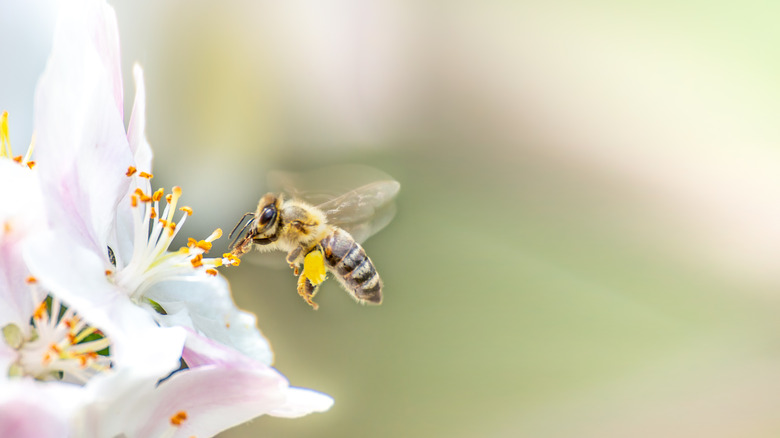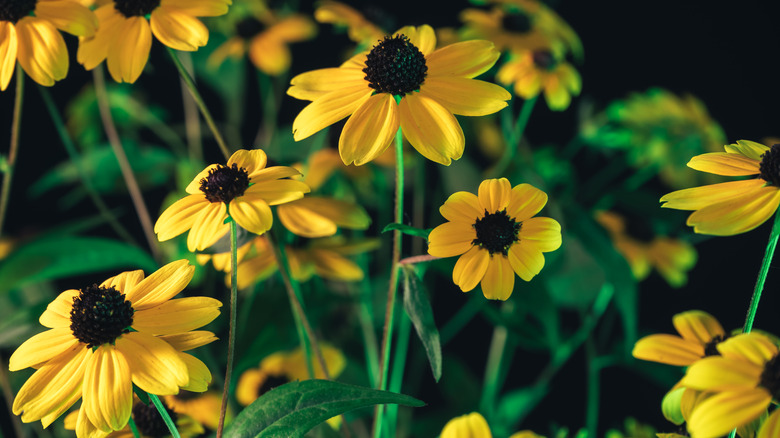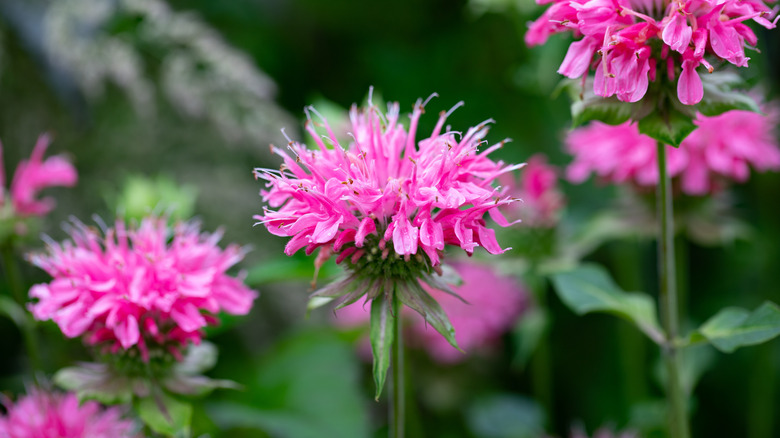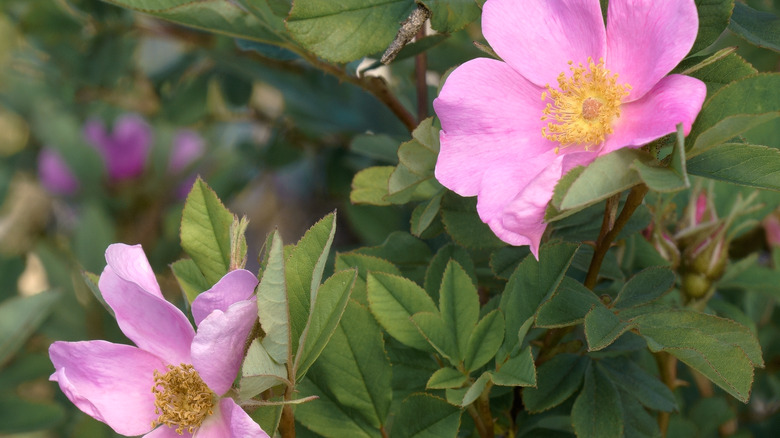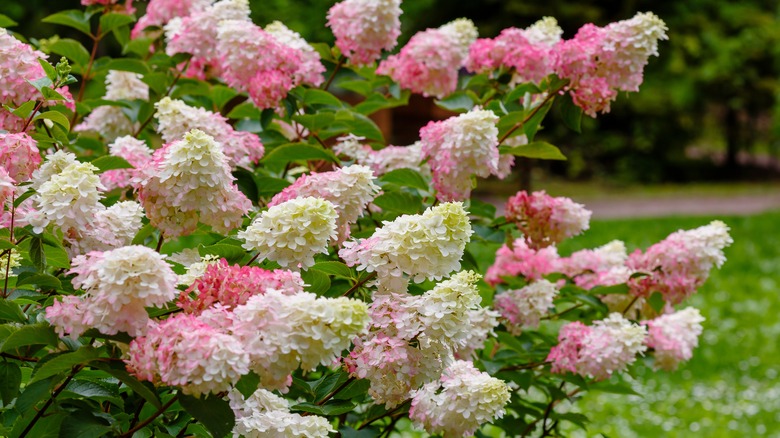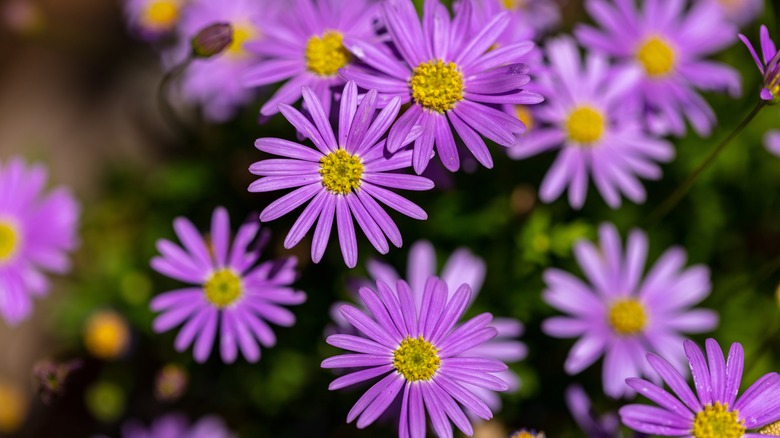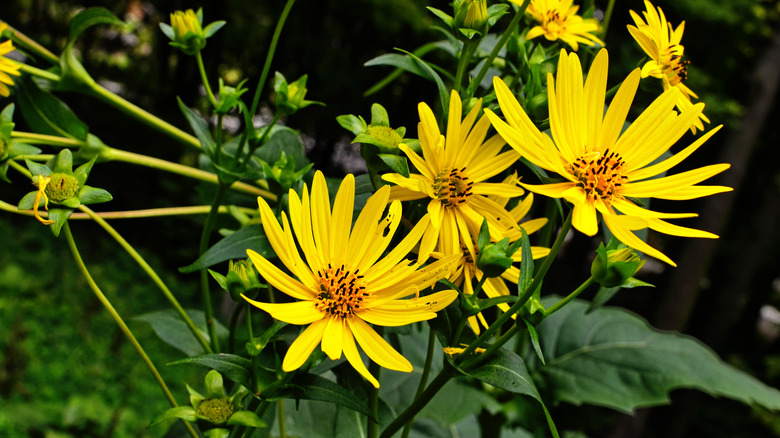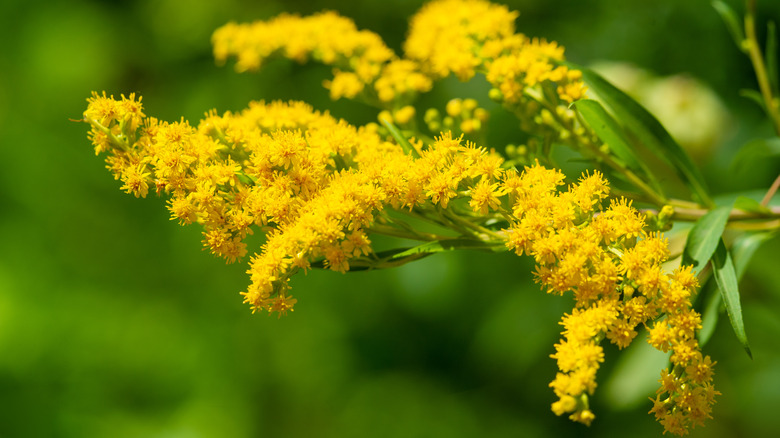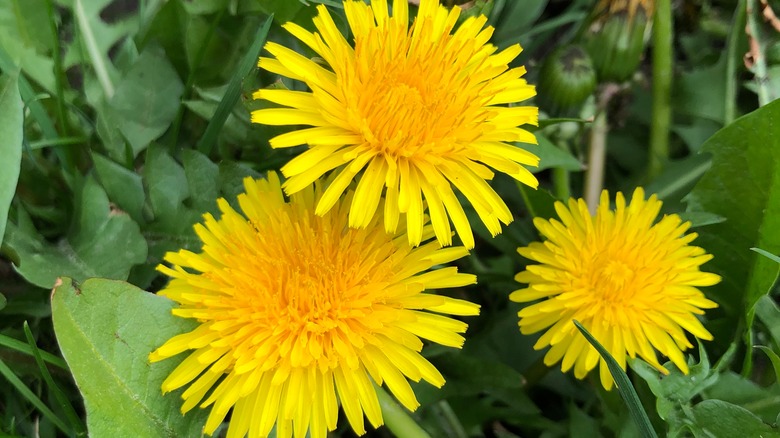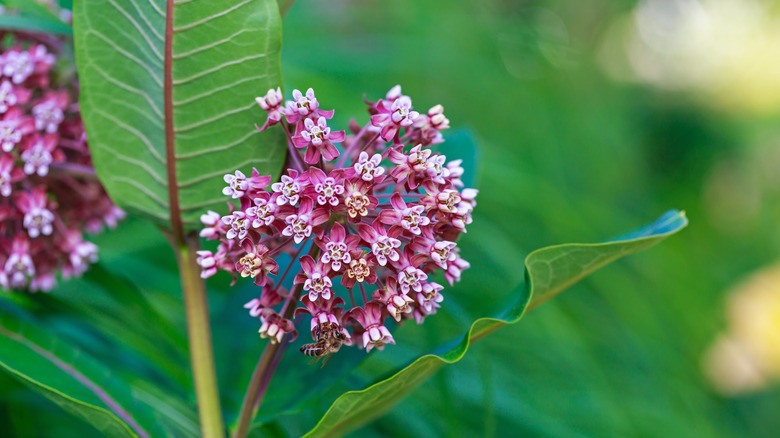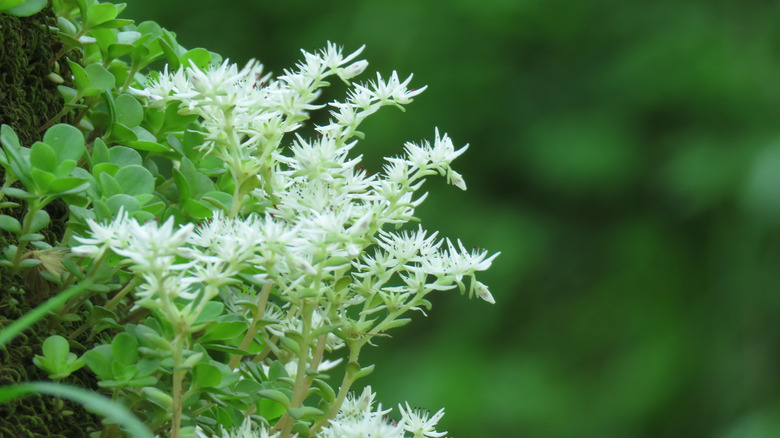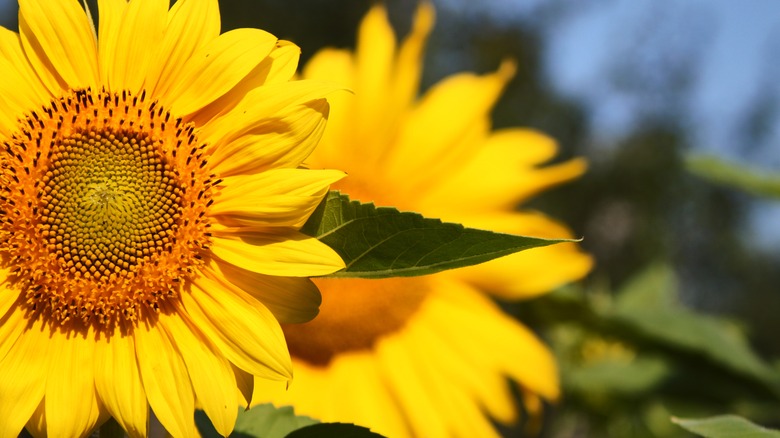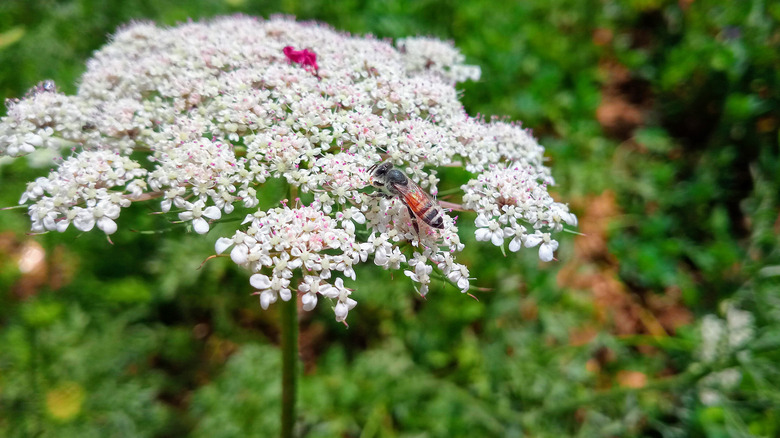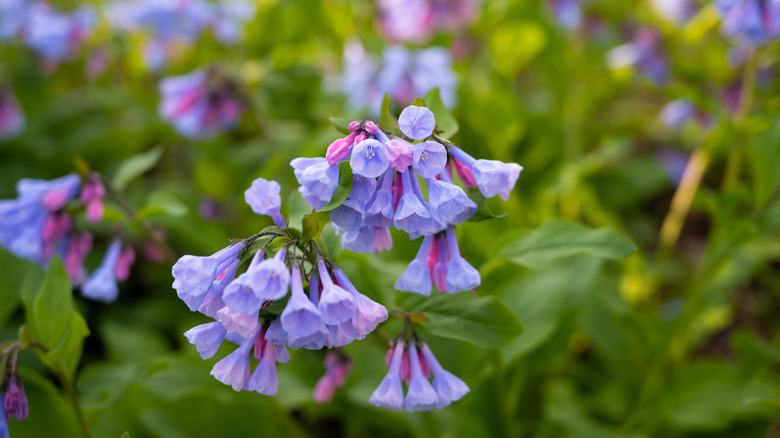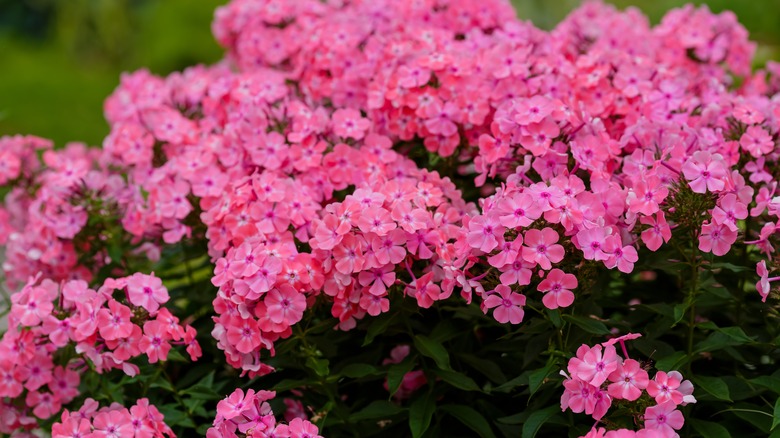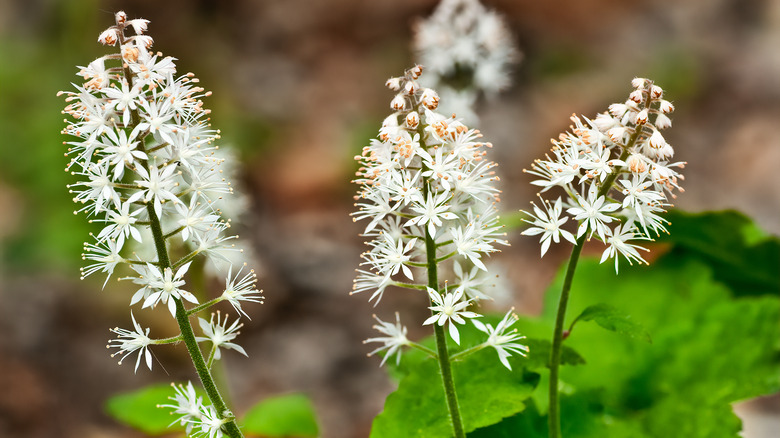15 Bee-Friendly Flowers To Grow If You Live In New England
It's no exaggeration to say that bees make the world go round. Their pollination efforts are essential to keeping the natural realm thriving. According to Tufts Pollinator Initiative, there are over 350 species of wild bees in New England alone, and the honey bee only makes up a small number of these flighty friends. Luckily, New England is home to many native perennials and conducive to several annuals from which bees love to pollinate and enjoy the nectar.
When you are creating a bee-friendly garden, you want to keep a few things in mind. First, ensure you get a variety of flowers that will bloom throughout the feeding season — planting only peak-season-bloomers will leave bees in need of food in early spring and fall. Additionally, keep in mind that not all pollinator-friendly plants are created equally. Bees prefer pinks, purples, blues, and yellows, while other pollinators, such as hummingbirds and butterflies, are drawn to reds and oranges. To drive down competition amongst bees and other pollinators, try to plant a diverse variety of flowers, herbs, shrubs, and trees.
1. Black-eyed Susans
Black-eyed Susans (Rudbeckia hirta) are a common native perennial to the Northeast of the U.S. that blooms in late summer and early fall, so they can be an excellent late-season food source. And while that signature black eye may seem pretty solid, it's actually a cluster of dozens of individual flowers, each serving as a perfect cup of pollen and nectar, per the University of Maryland Extension. Black-eyed Susans need moist, well-draining, acidic, or neutral soil with full sun exposure in USDA growing zones 3-7 and can grow up to 3 feet tall.
2. Bee balm
Part of the mint family, the bee balm (Monarda spp.) lives up to its name as a favorite pit stop for bees. It also goes by the common names horsemint or bergamot. As a member of the mint family, it grows rapidly, says American Meadows, so only place it where you don't mind it spreading or keep it in a self-contained planter to prevent invasion. Growing up to 2-4 feet tall and 2-3 wide, bee balm needs rich, moist soil and partial sunlight in USDA zones 4-9.
3. Virginia rose
When you think of a rose, you may think of velvety red, tufted petals, but consider the very bee-friendly Virginia rose (Rosa virginiana). Its single-flower petals make it easy for a bee to land on it and take nutrients from the yellow eye. According to Wildflower.org, you can even get the fruit of these flowers, the rose hip, and use it in the kitchen or steep it in tea for a vitamin C boost. The Virginia rose can grow up to 6 feet tall, needs well-draining, acidic soil and full sun, and thrives in USDA zones 3-8.
4. Panicle hydrangea
Also known as hardy hydrangeas, panicle hydrangeas (Hydrangea paniculata) are one of the most reliable hydrangeas you can grow in your garden, per Proven Winners. Panicle is a term that describes the shape of the blossoms — multi-stemmed ones. They flower in the late summer or early fall, which is great as a late-season food source. Panicle hydrangeas aren't too fussy but need partial to full sun (four to six hours per day) and loamy well-draining soil in USDA zones 4-8.
5. New England aster
Don't confuse the New England aster (Symphyotrichum novae-angliae) with the common daisy (Bellis perennis), though both are members of the Asteracae family. According to Minneopa Orchards, these plants have a long vase life and are used in many parts of the world to make wedding bouquets. These late-season-blooming New England flowers grow in zones 3-8 and thrive in neutral-acidic loamy, well-draining soil, and full sun exposure. They can grow to be up to 4 feet tall.
6. Cup plant
Another member of the Asteraceae family, the cup flower (Silphium perfoliatum) is a lemony yellow herbaceous perennial that is a favorite of bees and other pollinators. It gets its name for its leaves, not its petals, notes Backyard Ecology. A pair of conjoined leaves form a small reservoir, or cup, at the base of the flower, which can collect rain and dew, making it a great pollen and water source for wildlife. Growing in USDA zones 3-9, the cup flower needs full sun and wet soil or clay and grows between 4-8 feet tall.
7. Goldenrod
Commonly known as goldenrods, Solidago is a fantastic flower to plant in your pollinator-friendly garden. In addition to being a great source of pollen and nectar, goldenrod has been used medicinally for centuries. Solidago is Latin for "to make one whole or heal," per Healthline, making this plant helpful to bees and people alike. In USDA zones 2-8, goldenrod can reach up to 5 feet tall and 3 feet wide. It requires acidic to neutral, average, well-draining soil and full to partial sun exposure.
8. Dandelion
Even though your parents may have made you spend Saturday mornings pulling dandelions (Taraxacum), these are actually helpful flowers for our flying friends. Another member of the Asteraceae family, dandelion plants are flowering herbs that have long been prized for their beauty and medicinal use, says WTTW. So if your lawn is scattered with dandelions and they aren't encroaching on your other plants, let them bloom on peacefully as an offering to bees for pollen and nectar. These hardy, stubborn flowers require well-draining, neutral to acidic soil, full sun exposure, and grow in USDA zones 3-9.
9. Common milkweed
With monarch butterflies being classified as endangered, you've likely heard a lot about milkweed plants when it comes to this issue. The U.S. Forest Service notes that monarchs lack a host plant and food source for their larva without milkweed plants. But this flower isn't just for butterflies — bees also enjoy the rich milky solution found in it, making the plant a must-have for any pollinator-friendly garden. Common milkweed grows beautifully in the northeast region of the U.S. Give it full sun exposure and well-draining soil in USDA zones 3-9.
10. Woodland stonecrop
If you're looking for an early season, drought-tolerant pollen source for bees, woodland stonecrop (Sedum ternatum) is a great choice, blooming from April to May. The Native Plant Trust recommends using it in a rock garden as a sprawling low-growing accent flower because the plant only requires shallow soil, allowing it to sit on rocks and boulders with ease. It should be grown in USDA zones 4-9, with average soil and partial sun exposure for best results.
11. Sunflower
The heaven-facing sunflower (Helianthus annus) is one of the flowers that most excites happy summertime memories thanks to its canary yellow petals. It's also a great pollen and nectar source for bees, but not all sunflowers are created equally. Some species are over-engineered for size and looks, rendering them pollenless, says Joybilee Farm, so be sure to get a native variety for your garden. The sunflower thrives in well-draining soil with full exposure to sunlight, USDA zones 2-11 and can grow up to 10 feet tall.
12. Wild carrot
Also known as Queen Anne's lace, wild carrot (Daucus carota) is a part of the Apiaceae family. While you won't find any typical orange carrots on this bee magnet, its roots and flowers are edible, so you can enjoy them after the pollination season ends. Wild Food UK recommends cooking the root into a soup and eating the flowers raw or battering and frying them up. Wild carrots bloom in the peak summer season in USDA zones 3-9 and need full sun exposure and well-draining soil.
13. Virginia bluebells
Virginia bluebells (Mertensia virginica) are part of the forget-me-not family, and with these delicate trumpet flowers in shades of periwinkle and violet, it's easy to see why. They are a great source of pollen and nectar for bees and stunning addition to your New England cottage garden. In addition, they tolerate partial to full shade, so they're a good choice if your yard doesn't get a ton of natural sunlight and needs rich and moist soil in USDA zones 3-8.
14. Creeping phlox
Sometimes known as moss pink, creeping phlox (Phlox subulata) is a sprawling, low-growing shrub that is a dream plant for those with only the slightest of green thumbs. Meadows Farms also notes that this plant blooms in early spring, from March to April, so they're a great early season source for bees and other pollinators. In addition, they sprawl quickly and easily, making them ideal for filling in negative space in your gardenscape. Plant creeping phlox in full or partial sunlight, loamy, well-draining acidic, neutral, or alkaline soil, and USDA zones 5-9.
15. Running foamflower
Running foamflower (Tiarella cordifolia) is a hardy woodland vine sometimes known as a "running tapestry" plant thanks to its abundant, sprawling leaves. The delicate white flowers bloom from late spring through summer but leave behind evergreen heart-shaped foliage that lasts year-round, similar to maple leaves, per New Moon Nurseries, so this is great for a native garden that wants to eliminate the grass. It requires full or partial shade, sandy or clay soil of any pH level, and grows in USDA zones 3-9.
